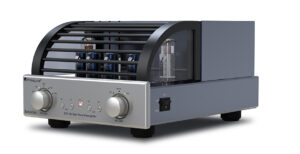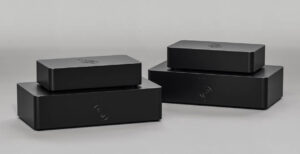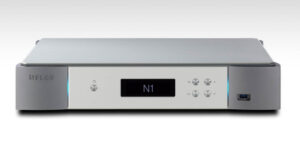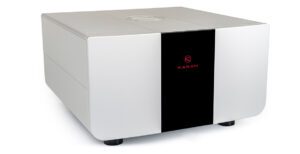
We are now well into what I might describe as the second-age of high-end steaming and dCS has completed its renaissance by discontinuing all its older models, leaving the company with three distinct product levels. Sitting firmly at the top is the Vivaldi, comprised of anything up to four boxes in complexity and quality, though there is also a limited edition single box model named Vivaldi One. Just below is the Rossini range, which recently had a separate SACD transport added. But now we have the Bartòk. At the moment there are two models. The straight Network DAC that you see here or the DAC plus integrated headphone amplifier, which costs approximately £2,000 more and that we will take a closer look at in the near future.
For me, the Vivaldi changed everything as far as digital replay and streaming are concerned and the Rossini obviously benefitted enormously from that platform. Now the Bartòk steps into the fray and the DAC is another impressive product that sets an extremely high performance plateau, with the potential for firmware updates long into the future. I have seen how the Vivaldi has benefitted from this over the years and how the Vivaldi DAC is now a far better and musically ‘deeper’ design than it used to be. This came about through work on just about every aspect of its technical performance through new mapping algorithms, digital filters, development of the Ring DAC, and other sections of the Vivaldi platform. For serious digital companies this open-ended commitment to future firmware updates has become the way forward and the Bartòk will be no exception.

Somewhere in the back of my mind and probably because I was bought up in the vinyl age, for a long time I had a simmering conflict where digitally encoded music is concerned. How can something as creative, limitless, organic, and human – along with all the billion nuances that the musical performance might contain – be contained within a tiny digital package ready to be regurgitated and reassembled while still maintaining all that speaks to us musically? For a long time, it seemed as though it couldn’t. I guess it sounds a little naive to ask such a question right now while I am sitting listening to that very thing happening so wonderfully through the Bartòk DAC, but it has long been a serious consideration for me. The over-mechanical, almost robotic realisation of rhythm and tempo, the somewhat bleached and chilly tonality of earlier bandwidth-limited streamed digital has gone now, as has the detached and harsh performance of the streaming services. But, these days, get the digital side right and the world of music is at your fingertips and it’s becoming more real and more human as time passes. I was, after all, a very late adopter.
The Bartòk is a full width box that doesn’t feature the sculptured front panel of the other dCS products, but it has just about everything else. It is an Upsampling Network DAC with full streaming abilities that borrows its Ring DAC from the Rossini.The company has been involved with intense development of their unique converter for a long time now. It’s one of the main weapons in their armoury and they have learned how to control and deploy it since its inception all those years ago. The Bartòk supports UPnP, asynchronous USB, and Apple Airplay as well as AES and S/PDIF digital audio streams. At the time of writing Bartòk is also entirely compatible with both Tidal and Spotify Connect, but I can imagine that other streaming services may well be on the firmware horizon plus increased compatibility with other operating platforms (apart from iOS perhaps). If you have a separate dCS CD transport (no options are currently available within the Bartòk range), it will accept everything up to and including SACD data through its Dual AES inputs.
Bartòk shares the same basic platform as the Rossini and, as such, should be utilised with the dCS custom control app that gives users the option to decide their source for music playback by offering digital and UPnP sources while also providing straightforward access to the DAC settings. Upsampling can be selected as either DXD or DSD and dCS have also provided a wide range of DSP filters that you could use to trim the unit’s performance for your individual taste. The combinations available are comprehensive, but my experience is that, after an initial period of experimentation, you will end up with a choice that suits you and your system and then you’ll most likely stick with that. The choice between DXD and DSD oversampling for instance had always been an interesting one for me and depending on the music and my mood, I can hear a strong case for either, although I tend to stay in DSD most of the time.
The Network interface is a critical aspect of the success of the dCS range and on the Bartòk it runs at up to 24-bit, 384kHz and DSD 128. It is capable of supporting all lossless codecs, plus DSD in DoP format and of course native DSD. The onboard clocking is derived from the dCS auto-clocking architecture from the Vivaldi.
If you are already plugged into a quality streaming service and have realised just how far this technology has come over the last year or so, then you are going to be delighted with what the Bartòk achieves. In systems like this, the upsampling network DAC capabilities of the Bartòk really does tie the whole streaming experience together seamlessly. If you like the functionality and the superb presentation of the Roon software, as I do, then so much the better. You can stream through Roon or you can access Tidal directly through the dCS Bartòk app. You can even spend your time comparing the difference between the two of them if that’s your thing. Tidal Masters offers increasing access to MQA encoded music and as you might expect, the Bartòk is your friend here too. Accessing the music you want, when you want it, at high quality or hi-def, is really what Tidal is all about. Roon gives you a more elegant browsing experience with reviews and facts about the music and many links to enable you to seamlessly cruise around the extensive library. For a long time I saw the whole streaming ‘thing’ as a second source, but no more: it has become the go-to listening set-up and over the past couple of years I have been lucky enough to have experienced all the dCS streaming solutions, as well as a few others. And if you see your future access to music as being streamed, then the Network DAC is going to lie at the heart of your system. Also, the time has come where the different sounds of available DACs have become more and more evident. So much so in fact that I find there is only one way to discuss their various merits and that’s through the prism of their musical performance.

But, look a bit deeper. Gaze into the heart of the music and you will find that artistic, instrumental, and vocal composure, and especially their complexities, show significant differences between components from different companies. I’m someone who tends to ask the simple question, “Am I enjoying the music?” If I know a piece well, I will consider if this version brings anything new in terms of technique or nuance, or whether it is just different. There’s a perfectly understandable human trait when considering music and audio systems, to regard what we know as some sort of reference of ‘rightness’ and to measure all newcomers against that. But, overall, I have also found that, if the system does small things like getting the leading edges just right and has expansive timbre, then it’s usually pretty good. Down at note level, the Bartòk, like the Vivaldi and Rossini before it, is exemplary. That minuscule moment where the instrument or vocal-chords are energised is more than important: it’s critical. Get it right and the rest can often follow. Get it wrong, in that there is a touch of compression or a minuscule blurring, and you can be left with what I would term a leading edge ‘blister’ and it will seldom be as satisfying despite the initial feeling of speed and excitement. I would also add here that, despite enormous strides being made in the streamed quality, there are still times when things just aren’t right and you are dealing with a less than optimum music file and then it can sound awful. Perhaps this is to do with the location of the source in question or there may be some variance in the original quality along the line. I really don’t know but, from the evidence of my own ears, these incidents are getting rarer and, in this regard, things are definitely improving.
Bartòk, like the other current dCS DACs, has a very capable variable output stage that can be utilised to drive a power amplifier through either single-ended or balanced connections. Control is accessible through the app, the optional remote, or via the front panel knob. Historically I would avoid using these in preference to a dedicated preamplifier, but the model that dCS incorporates is rather good and ,unless you have a really superb preamp, you may well find it preferable, which would eliminate the expense of a separate preamp and cabling. Output levels are switchable too through the deeply comprehensive menu system. If you are using headphones, then the low output settings of 0.2 or 0.6 will be relevant, but for straightforward output levels into a pre or power amp the choice is between 2v or 6v RMS. If your preamp has enough headroom then I am going to suggest that 6v is the way to go. The musical ride is more interesting and the system inevitably sounds faster, more dynamic, and generally ‘on it’, if you know what I mean.
Although I have spent hours and hours with both the Vivaldi and the Rossini systems, I never felt that the Bartòk was a significant step down. Its performance is so complete and beautifully balanced; it remains completely focused at whatever you ask it to do, and it has a way of projecting the music through its wide soundstage with a stunning sense of musical separation and then aiming lead vocals or instruments straight across the room at you. Its ability to superimpose layers and layers of musical detailing one upon the other is really enjoyable and quite overt at times. I was taken aback on many occasions at just how fresh and hard-hitting it could sound. I might even describe it being forward. This exuberant liveliness is addictive. You probably won’t listen to Agnes Obel’s Late Night Tales [Night Time Stories] for the stinging heavy-metal in her music. Agnes is about space, texture, and mysterious and dark ambience – and the Bartòk is expansive in these situations. It maintains a wonderful sense of occasion and often conjures up a rather spooky mood. It is colourful too and full of nuance both tonally and expressively. Throughout her 2010 album Philharmonics [Play It Again Sam records], Obel coaxes the piano into some interestingly atmospheric situations, changing the mood by feeling out the notes and colouring them with her technique. As the opposing instrumentation lays across the backdrop it throws the piano into stark relief and the bass washes around between the speakers until her rather ethereal voice just happens and kicks you in the face.
The Bartòk’s command of such relative volumes and its ability to paint dynamic tonal colour with such bright markers is marvellously expressive, intimate, and perhaps best of all, surprising. But all this is tied together by a superb sense of sheer dimension to the musical presentation. The music lives and breathes, has height, width, and depth, and is always interesting enough to lead you on to new pastures. It is powerful too with a really tangible feeling of strength and weight allied to heavy-duty rhythmic impact. You can spend a long time in front of your system with a Bartòk.
dCS has always been acknowledged for its high-resolution systems, but these days it has managed to merge that with a distinctly musical and indeed colourful feel. Digitally streamed music through the Bartòk feels entirely joined-up and full of rhythmic transient movement and life. Both the flow, tempo, and lack of digital emphasis are really satisfying, especially if you are someone who likes to immerse themselves in the whole atmosphere and performance.
There is perhaps a rather understated, conservative austerity to the look of dCS equipment, but in use it has a driving, potent musicality about it that is anything but. Regardless of the source, the Bartòk is a winner. Used as a Network DAC it is extremely impressive. But add its high-quality variable output stage and the certainty that updates will keep expanding its musical abilities into the future and it makes a lot of sense. I really can’t fault it.
TECHNICAL SPECIFICATIONS
- Type: Upsampling network DAC (Headphone version available)
- Converter: dCS proprietary Ring DAC
- Digital Inputs: Network Interface through RJ45 connector, USB 2.0 on B-type connector, USB-on-the-go type A connector (Asynchronous mode), 2 ×AES/EBU XLR, 2 × SPDIF (1 × RCA /1 × BNC, 1 × optical Toslink
- Analogue Outputs: 1 × stereo pair XLR, 1 × stereo pair RCA
- Output levels: 0.2, 0.6, 2 or 6V RMS, selectable in the menu
- MQA: Full decoding and rendering of MQA data from Network and USB ports
- Upsampling Conversions: DXD as standard with option of DSD
- Software Updates: Download through Bartòk app
- Filters: PCM mode – up to 6 filters. DSD mode – 4 filters to progressively reduce out of band noise
- Control: dCS Bartòk app. dCS Universal IR remote available as optional extra
- Dimensions: 115 × 444 × 430mm (H×W×D)
- Weight:16.7 kg
- Colours available: Silver or Black
- Price: £9,999
Manufacturer: Data Conversion Systems
URL: dcsltd.co.uk
Distributor: Absolute Sounds
URL: absolutesounds.com
Tel;: +44(0)20 8971 3909
Tags: FEATURED
By Chris Thomas
More articles from this authorRead Next From Review
See all
PrimaLuna EVO 100 phono preamplifier
- Apr 22, 2024

Reiki Audio SuperSwitch Master Pro + Servant Pro
- Mar 27, 2024

Melco Audio N1-S38 music server
- Mar 27, 2024











